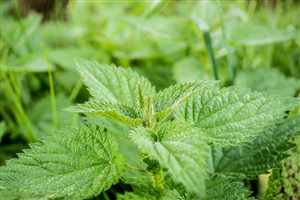Nettle (Urtica dioica)
Main Facts about Nettle

Using Nettle
Nettle may contain properties that help to reduce nasal inflammation and ease allergy symptoms, particularly hay fever. Nettle posesses antihistamines which act against the body’s natural response to produce nasal congestion and watery eye in response to pollen and other allergens. Nettles may bring relief upon people who have excess uric acid built up in their bodies. The most common way to bring relief to joints inflamed with gout is by brewing a cup of stinging nettle tea. Alongside vitamin C and cranberries, drinking tea made of stinging nettles can further help in the treatment of a bladder infection by easing the inflammation of the bladder or urethra. Drinking nettle tea also promotes urination which flushes the body of infection causing bacteria. Drinking a cup of nettle tea every day may promote healthy nail growth as nettles contain silica and other minerals necessary for nail formation. Drink stinging nettle in teas to reap the most benefits for osteoporosis and the bone loss that is often associated with arthritis. While non-steroidal anti-inflammatory medication (NSAID) is necessary evil for most with arthritis, using nettle may help you to decrease the amount you need to take. The leaves can be used raw and applied directly to the rheumatic pain area, they increase circulation and draw out pain. While most people avoid the stinging part of the nettle, those with arthritic hands deliberately prick there hands to calm inflammation and pain.Nettle is a remedy for: Arthritis
Caution!
Only young leaves should be used because older leaves develop gritty particles called cystoliths which act as an irritant to the kidneys. Stinging nettle grows well in nitrogen rich soil, blooms between June and September, and usually reaches 2 - 4 feet high. Central nervous system depression drugs (e.g. morphine, alcohol) may also interact with nettle. Avoid during pregnancy.Cooking with Nettle
Exposing Nettle to heat for about 30 seconds (like boiling water for tea or soup) neutralizes the sting, as does drying the leaves. Use the dried leaf in teas or sprinkled it onto food like parsley. Use Nettle instead of spinach, very good in soup.How to grow Nettle
Nettle grows well in nitrogen rich soil, blooms between June and September, and usually reaches 2 - 4 feet high. Few people propagate this plant on purpose, but transplanting young plants from stolons or rhizomes is easy. Seeds easily - just rub the mature seed heads, releasing the seeds, over where you want it to grow. When working with Nettle always use gloves! Cut off the flowering heads to reduce seed production - typically done in late Summer when the plants are tall. At least once a season, and maybe a few times, pull up any plant that is growing outside of where you want Nettle to grow.Nettle Toxic Look-alikes
There is only one known species of nettlewhere the sting is too strong and dangerous, called Urtica Ferox.| Myrrh |
Oats
|